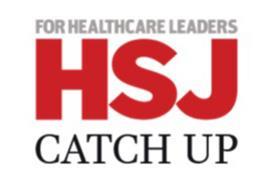Seventeen trusts have taken on the challenge to raise care standards, making staff concerns the starting point for change, writes Hannah Forbes.
Over the past few years, the Listening into Action approach has been developed − through co-design with more than 70,000 NHS leaders and staff − as a practical, outcome-oriented vehicle for building high performance through the direct, widespread engagement of staff.
They are empowered to lead change for the benefit of patients and themselves.
Following a gradual spread from one organisation to another, 17 trusts have just started their journeys as national pioneers on staff engagement and empowerment, through parallel adoption of Listening into Action as a new way of working.
These trusts have been “qualified in”, based on a high level of commitment to a set of proven success factors. Other trusts were “qualified out’ where their intent seemed more like lip service.
Each of this first wave of trusts − under the inspirational leadership of their chief executive − has achieved a significant amount within the first four months.
Seventeen national pioneers on staff engagement and empowerment
Wave 1 (May 2012)
- East Sussex Healthcare Trust
- Hull and East Yorkshire Hospitals Trust
- Kettering General Hospital Foundation Trust
- Northampton General Hospital Trust
- Oxford University Hospitals Trust
- Pennine Acute Hospitals Trust
- Royal Cornwall Hospitals Trust
- Taunton and Somerset Foundation Trust
- Wrightington, Wigan and Leigh Foundation Trust
- Medway Foundation Trust
Wave 2 (September 2012)
- Royal Liverpool and Broadgreen University Hospitals Trust
- Croydon Health Services Trust
- Berkshire Healthcare Foundation Trust
- Coventry and Warwick Partnership Trust
- East Cheshire Trust
- Aintree University Hospital Foundation Trust
- Wirral University Teaching Hospital NHS Foundation Trust
Expressions of interest are already coming in for a new cohort of trusts to start in early 2013. The aim is to include groups of locally connected trusts to leverage the opportunity for cross-boundary collaboration.
The trusts have started the spread of a simple, proven, outcome-oriented way of working that fits with their own local context, independent of external interference. They have gained an unprecedented and honest picture of what matters to their staff and a snapshot view of how engaged and valued they feel right now − the starting point for meaningful change which will enable and unblock the way to great patient care.
In addition, they have identified and mobilised a range of big impact, coordinated, staff-led actions at the front line and in support areas, which will create inspiring local evidence and fuel wider spread.
The process itself helps to shift the style of leadership by building competence and confidence at all levels to lead through engagement.
In this work the trusts have established themselves as part of a growing network of national pioneer trusts that follow a common “route map” and meet regularly to share learning.
Measurable results
These trusts had compelling reasons to sign up as “national pioneers” following the results achieved by nine early adopter LiA trusts. Reasons included:
- an increase in staff survey results of up to 26 per cent within the first year, with year-on-year improvements since then;
- a corresponding improvement in patient feedback;
- up to 35 per cent improvements in staff morale, measured through a “one minute of your time” LiA staff “pulse check”, which provides a snapshot view of how engaged and valued people feel;
- reduced levels of staff sickness;
- a huge array of “big impact”, staff-led changes for the benefit of patients, including less waiting, fewer hospital visits, services to suit patients, reduced mortality rates, availability of notes, better communication, smarter environments;
- a wealth of corporate-wide “step-changes” to enable people and unblock the way so that staff can get on and do their jobs, including a focus on IT, customer care, communication, “what it means to be a leader around here”, living our values, and bureaucracy busting.
The parallel adoption approach creates a valuable opportunity for cross-learning between the pioneer trusts. While each one rightly focuses on their own journey − one size never fits all and “intelligent application” of the approach to the local context is vital − each cohort of trusts is committed to following the same route map with common milestones over an initial 12 months.
The ultimate destination is a fundamental shift in the way we work and lead
As part of this, a series of navigation days bring the chief executive and four to five other key sponsors from each trust together to compare notes as they go.
This creates a positive pressure to keep up momentum, and an important opportunity to network, share ideas and inspiration and build connections between trusts.
The aim for the initial 12-month journey is for every trust to get to a point of traction whereby new, engaging ways of working are spreading and embedding as “the way we do things around here”.
Embracing change
The ultimate destination is a fundamental shift in the way we work and lead, putting staff at the centre of change. It is widely recognised that high performing organisations succeed by getting staff to work together better. The Francis report into Mid Staffordshire Foundation Trust, due in the New Year, will surely make interesting reading for the NHS in this regard.
Each national pioneer trust has committed to:
- their own local journey of adoption, but on a parallel timescale to the rest, which will take place over an initial 12-month period based on a common route map;
- LiA being sponsored and led by the chief executive, with support from a sponsor group of key influencers, especially clinicians;
- appointment of a full-time LiA lead who organises, coordinates, coaches and supports the effort on a day-to-day basis, reporting directly to the chief executive;
- attendance by the chief executive, LiA lead and two to three other influencers at a series of navigation days to share learning and navigate the process together;
- input from experts who are a virtual extension to their own team, and day-to-day use of the web-based LiA Navigator to access knowledge and avoid reinvention;
- taking ownership and responsibility for success - as the focus is on helping them to do this for themselves and embed it as “the way we do things around here”;
- sharing of stories and learning across the network, and at a national and international level.
The initial 12 months is not for the faint hearted. Led by their sponsor group and supported day-to-day by their LiA lead, each trust goes through a carefully crafted, evidence-based journey which is about achieving a huge uplift in how listened-to, empowered and valued staff feel.
It is about making a step change in key areas through “enabling our people” schemes, which unblock the way and enable staff to do their jobs more easily.
By the end of the initial 12 months, each trust will have been through a steep learning curve
Also important is empowering the first 10 and then a further 20-30 pioneering teams − pathways, services, departments, wards − to adopt LiA and to engage the right people around the positive changes to take ownership in making them happen, quickly and with pride.
By the end of the initial 12 months, each trust will have been through a steep learning curve, mobilised a critical mass of people, shown the impact of this approach through stories and results, and be well positioned to spread this into the rest of the organisation in a way that will sustain and flourish.
LiA staff pulse check results
The first national pioneer trusts represent a cross-section in terms of national staff survey results and organisational performance.
Their LiA staff pulse check results − from 19,700 responses in July-October 2012 − are typical for the NHS and demonstrate the huge opportunity to “raise the bar”, create a new level of ambition, and change paradigms in the way we work and lead.
More important than the results themselves is the commitment of NHS leaders to recognise the size of the opportunity and be courageous in acting upon it.
This is exactly what the pioneer trusts are doing.
- 52 per cent of staff feel happy working in their work area/team/department… so 48 per cent do not.
- 30 per cent feel involved in deciding on changes introduced that affect their work area… so 70 per cent do not.
- 31 per cent feel that senior managers encourage staff to suggest new ideas for improving services… so 69 per cent do not.
- 16 per cent feel day-to-day issues and frustrations that get in our way are quickly identified and resolved… so 84 per cent do not.
- 28 per cent feel their trust communicates clearly with staff about what it is trying to achieve… so 72 per cent do not.
- 38 per cent believe we are providing the very best services to our patients and their families… so 62 per cent do not.
- 19 per cent are satisfied with the extent to which the trust values their work… so 81 per cent are not.
- 59 per cent feel proud to work in their work area/team/department… 41 per cent do not.
- 42 per cent feel they understand the connection between their role and the wider vision of the trust… so 58 per cent do not.
- 20 per cent feel that communication between senior management and staff is effective… so 80 per cent do not.
The LiA staff pulse check comprises 10 simple questions and takes less than a minute to complete. Four questions correlate with the national staff survey to enable comparison. Staff score each question 1-5 where 1 = not at all and 5 = very much so.
The results are based on scores of 4-5 being acceptable and scores of 1-3 demonstrating an opportunity for improvement.
Quick wins
The first wave of 10 trusts hit the ground running in May and have already:
- got leaders and influencers on board with the need for a fundamental shift so there is a strong sense from the outset that “we are all in this together”;
- conducted an LiA pulse check of 13,000 staff to get a snapshot view of how engaged and valued staff are feeling right now, using this to underpin the case for change;
- held LiA staff conversations (more than 4,000 staff in total) where staff share their views on what matters, what gets in the way, and ideas for action;
- consolidated this into locally framed themes which provide a compelling, unprecedented view of “what matters to our staff” and form the basis for change;
- generated quick win responses − forming a repository of more than 150 − which each trust is drip-feeding each month to build belief in the process;
- translated “what matters” themes into top ideas for corporate “enabling our people” schemes;
- mobilised the first 10 pioneering teams − pathways, wards, departments, community teams, service areas − who will adopt Listening into Action on the ground, with the full backing of the trust over an initial 20 weeks and then beyond.
The emerging stories from the first 10 teams and the “enabling our people” schemes will be high profile over the next 20 weeks, culminating in a “pass it on” event early in the new year to share inspiration and enable the next 20-30 teams to hit the ground running.
And so the groundswell begins − a plethora of staff-led change for the benefit of patients; an organisation that knows how to engage staff around the radical adjustments needed at a corporate level to enable and unblock the way for the people who work there; managers and leaders who increasingly see it as their job to ask “what can I do to help?” and take action to remove obstacles, with a growing sense of pride and ownership at all levels.
Hannah Forbes is director of Optimise
Downloads
What matters to staff in the NHS
PowerPoint
Topics
Turning concerns into positive outcomes
- 1
 Currently reading
Currently readingTurning concerns into positive outcomes
- 2

























4 Readers' comments